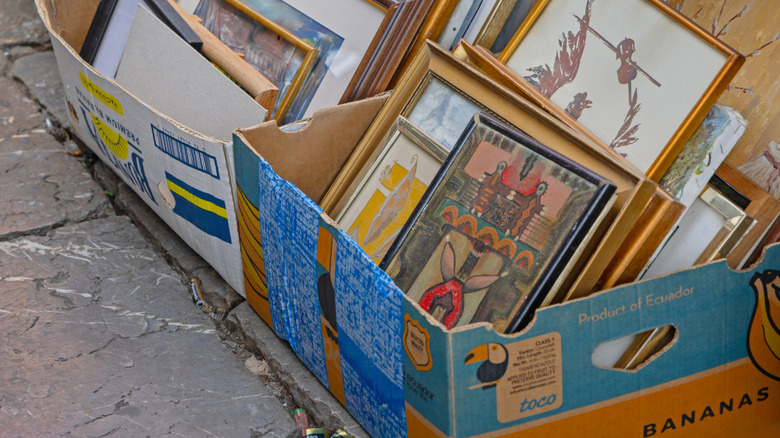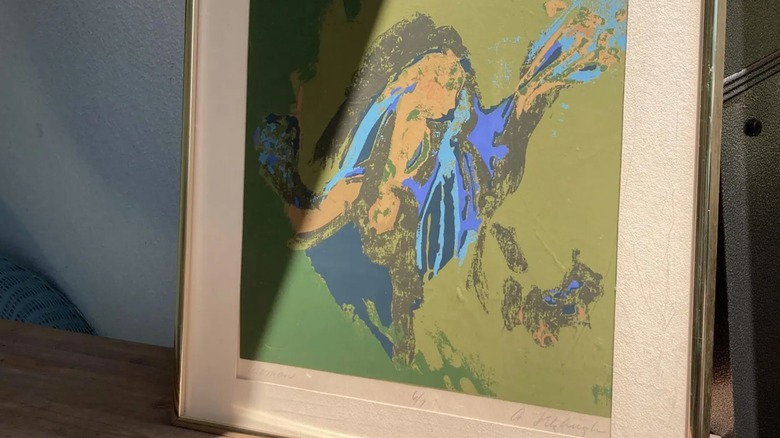Those Weird Vintage Art Prints At The Thrift Store Can Be Far More Valuable Than You Think
We may receive a commission on purchases made from links.
As you stroll along the aisles of your local second hand shop, you may come across loads of paintings, posters, and prints that work as wall art instead of buying from home décor stores. But don't just pick willy nilly or skip them because they look too old-fashioned. Instead, did you know that those weird vintage prints at the thrift store can be far more valuable than you think?
Art prints come from the practice of printmaking where one reproduces a piece of art usually through drawing, carving, and inking, before it is copied in limited quantities. These finds can be linocut, abstract, etchings, and even photographic versions. They typically are labeled with numbers indicating what position they were printed out of the total number made. Some options even go through a series of prints during and after an artist's lifetime.
Limited editions and lifetime prints (ones made while the artist was alive) are significantly more coveted than late impressions and mass productions. Prints can be just as valuable as the painting it was reproducing, selling for millions like Andy Warhol, Edvard Munch, and Pablo Picasso prints. In 2017, for instance, a woman in New Hampshire paid just $4 for an N.C. Wyeth illustration that ended up being worth almost $200,000. While you may not find a piece at the thrift store that will give you millions, you may be able to score some higher-end items that may sell for hundreds or thousands of dollars for cheap. When you find these vintage art prints, it's important to know how to authenticate them as well as how to style them in your own home.
Look at age, condition, and specific markers to help you authenticate any vintage prints you find
While searching through your thrift store, you'll find loads of prints. Some will be framed. Some may be in plastic wrap. Others may just be laying out on their own. But not all prints are retro or are even valuable. That's why you need to examine its overall condition, series marker, year and date, and chop mark. It's important to know that vintage pieces will show their age, especially if they haven't been properly preserved. You may notice a musty odor, brownish-red marks, a brittle feel, and cracks through paint on older, authentic pieces. However, some well-preserved options may be in pristine condition.
The fewer replicas made, the more valuable it is. However, popular artists may have their works reproduced over and over again, degrading the value of later prints. While not all pieces will tell you, the year, date, and artist signature can help you determine if it is real or not. Also, look for a chop mark or seal, indicating who the printmaker or publisher was. Without this mark, you may very well be looking at a contemporary reproduction. Sometimes prints will include some of these indicators, all of them, or none at all, making it confusing. When you are authenticating your latest thrift find, don't be afraid to reach out to a professional appraiser or expert when in doubt.
Work into a gallery wall or create a display to show off retro art prints
Just because you can make some good money with these valuable vintage art prints, it doesn't mean you should miss out on the opportunity to set them out in your own décor. Two great ways to add a vintage print to your home's aesthetic is to make it part of a gallery wall or to display it on a shelf or cabinet. Before you do either, you'll want to frame your print for easier hanging as well as additional protection. Measure the piece and find a durable frame that will protect it for years to come. Don't forget that you'll need to dust and keep it away from the sun to prevent fading. Once framed, you can create the perfect gallery wall with your funky art piece by pairing it with other vintage paintings and art prints, or anything else that matches the theme.
You don't have to put a framed art print on the wall. Instead, you can curate a fun display to show it off. Set the piece out and decorate with items that match the theme or pair it with other funky, retro finds from the era. If you have multiple art prints, you can even display them on a floating shelf or a glass cabinet display case. No matter where you put it, ensure that it isn't near a sunny window or moisture zones. Also, upkeep by dusting and cleaning the glass.

